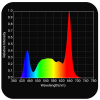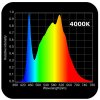First image shows how deep the canopy is and how bleached the tops are.
Not to be contrarian, but I don’t see any bud bleaching in any of those photos you posted. Some potential light stress, but not bleached buds.
So another quetion would be, are harvesting times increasing along with yield? And if so, doesn't this represent an increase in yield over watt-hours or not?
I don’t think gauging harvest times was part of the scope of their studies, though harvest times can be manipulated through means other than light intensity also (dropping air temps, reducing root temps, shortening daylight hours).
If you increase yields by1% but your watt-hours increase by 2%, then you have actually gone backwards.
This is not actually how business works.
The company said they experienced a linear 1% increase in yield for each 1% increase in total ppfd, up to 1800 ppfd. (But plants were illuminated up to 2500 ppfd)
Say hypothetically, they were to run 50 Kilowatts to illuminate 1500sq ft. of canopy at an average of let’s say 1200 ppfd. Let’s say their average yield was 150lbs over 9 weeks (63 days). They want to increase light intensity to 1800 ppfd by lowering the lights, so total light watts aren’t affected. They are running an average of 600 Kilowatt Hours per day (from lights). Over the whole run they are using about 37,800 Kilowatt Hours.
If the yield increases by 1% for each additional percentage that ppfd increases (up to 1800ppfd), the. They should experience approximatey a 33% increase in yield, according to the study. Let’s say this caused their plants to push out more growth and they ended up finishing in 10 weeks (70days) instead of 9 weeks.
If the yield/intensity trend were to hold true, they have now used 42,000 KW Hours over 10 weeks, approximately a 10% increase in energy from lights, but have also yielded almost 50 lbs more (199.5lbs) about a 33% increase.
Depending on flower prices and electrical prices, the net gain will vary. But for discussion purposes, let’s say flower is going for $800/lb and electricity is going for $0.29/KW Hour.
The additional light energy used for 1 extra week would cost $1218.00. The additional revenue from 49-1/2 lbs more yield would be $39,600.00 for the flower cycle.
Even accounting for 1 weeks additional payroll, as well as 1 more weeks worth of environmental equipment running, I’m pretty sure the increase in yield would VASTLY outweigh the additional overhead costs.








